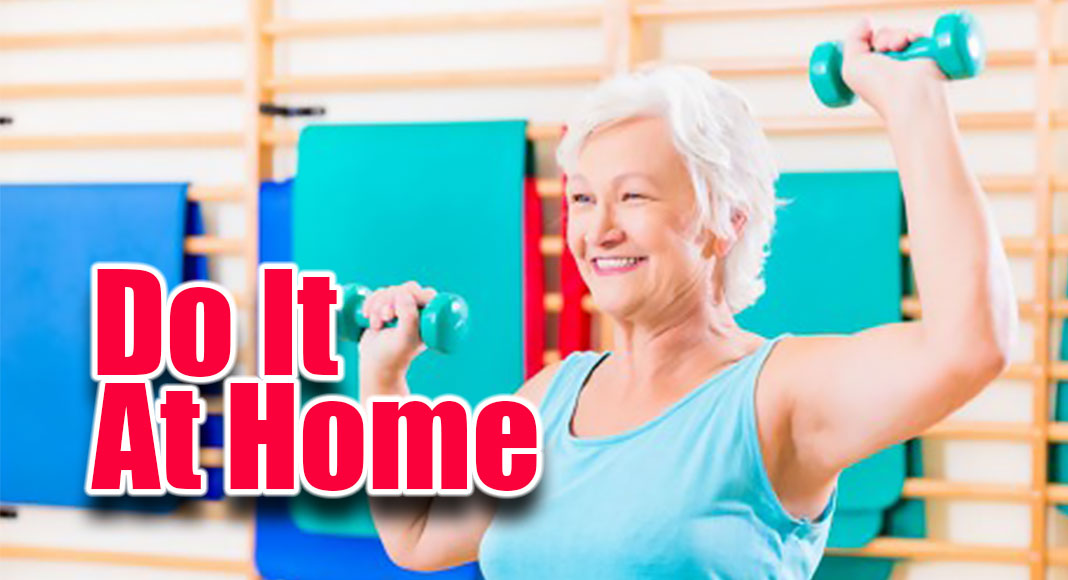
Texas Border Business
By Chulalongkorn University
Newswise — As you get older, exercise is becoming too important to ignore. But with the intermittent lockdown and social distancing measures over a long period, the elderly need to keep themselves at home, and stay away from social activities and exercises in public places, be it jogging in the village, Tai-chi in the park, aerobics next to the mall, yoga at the gym, or light-sport in a courtyard.
“Being quarantined at home may keep the fragile elderly away from COVID-19, but other health problems may arise, if they do not keep moving or exercising their body and mind,” Asst. Prof. Dr. Adit Chiradejnant, Lecturer, Department of Physical Therapy, Faculty of Allied Health Sciences, Chulalongkorn University said with concern.
“Generally, as people age, the functioning of the bodily systems, such as metabolism, food absorption, motor systems, as well as musculoskeletal systems slow down and become weaker. The body fatigues more easily and can result in depression. Regular exercise helps to slow down the degeneration of the systems and enhance their well-being,” Asst. Prof. Dr. Adit said as he was proposing creative ways to exercise and keep social distancing to promote seniors’ well-being.
The key to exercising “correctly” and “safely”
Exercise does not only improve the quality of life of the elderly as a whole, it also helps the circulatory system, enhances the gas exchange, reduces the risk of coronary heart disease, cholesterol, and blood sugar. The motor system also improves. The muscles, joints, and nervous system have better coordination, thus reducing the risk of falling. Moving the body can also help stimulate the internal organs. Moreover, exercise also affects the secretion of sleep-induce substance that brings better sleep, reduces stress, and lower the risk of depression.
Asst. Prof. Dr. Adit recommends two types of exercise suitable for the elderly.
1. Cardiovascular exercise
starting from light to more intense, such as walking, jumping rope, climbing stairs for a 30-45 minute duration that is long enough to stimulate the cardiovascular system.
2. Coordination exercise
to strengthen the coordination of the nervous system and motor control. Older people are prone to falling resulting from the loss of balance. Easy coordination exercise to enhance neuromuscular connection are such as walking with crisscrossing legs forward and then backward in a zigzag pattern, high knee walk while alternately touching the elbow or hand to the opposite knee, or the easiest way is to exercise with video clips, like aerobics dance, because this promotes body coordination.
Asst. Prof. Dr. Adit discussed how to get the most out of an exercise that should be continuous for 30 – 45 minutes per session, at least 3 times per week. It’s also important to warm up and cool down before and after every workout to avoid injury. And no matter what type of exercise, the important thing to pay attention to is “heart rate and breathing”.
Asst. Prof. Dr. Adit recommends that the elderly always monitor their heart rate, using the formula “220 – age = maximum heart rate”. During light exercise, the heart rate should not exceed 50 percent of the maximum heart rate.
“For example, the maximum heart rate for a 60-year-old person is 220–60 = 160, so the target heart rate for light exercise should be 80 beats per minute,” explains Asst. Prof. Dr. Adit.
“And if you still feel fine during the exercise, and want to increase the intensity of the workout, you can increase your heart rate to 60-70 percent of your maximum heart rate (96-112 beats per minute) for a moderate exercise but keep it under 80 percent of your maximum heart rate (128 beats per minute),” Asst. Prof. Dr. Adit adds. He also cautioned the seniors with health problems such as high blood pressure, or a heart condition to consult the doctor about proper exercise, and also carry an exercise aid, like a heart rate monitor, which now comes as a wristwatch. The other recommended equipment is an oximeter to ensure safety.
“Should there be some worrying signs such as chest pain, numbness in the arms, tongue, or face during the exercise, you must stop immediately and observe the symptoms. If you stop exercising and the symptoms are gone immediately, you may start exercising again, but at a lighter intensity than before. Also, if you feel irregular heartbeats, you must stop immediately,” Asst. Prof. Dr. Adit advises.
Exercise with housework and gain both good health and a nice home
The parks, fitness centers, and various exercise clubs may be temporarily closed, but you should not forget that your “home” is also a good and the safest place for exercise during the COVID-19 pandemic. For seniors who have exercise equipment at home, don’t leave those machines idle. Get up and walk or run on a treadmill, or get moving on the exercise bike, etc. But if you don’t own any equipment, you can exercise using what is available in your home, like water cans, filled water bottles as weights.
Moreover, walking up and down the stairs can also be an exercise. You may increase the number of laps, or speed it up. You can also make it more fun by playing music while you walk as well,” Asst. Prof. Dr. Adis suggested.
Doing housework is also a good exercise, gaining both health and clean and tidy home.
“Whether it’s washing the car, sweeping the house, wiping the floor, you can do these activities with fun rhythms and songs. You can also add some exercise moves into your household chores, such as squats, zigzag walks, alternating brisk walking, or jumping. To make housework an exercise, you should do it continuously for 30-45 minutes. You will gain speed, perform push and pull moves using more energy than normal housework.”
Stuck at home, but you can still run because duration is more important than distance.
“What matters for running isn’t distance. It is the heartbeat and the duration of the exercise,” Asst. Prof. Dr. Adit emphasized. Therefore, even at home where you can’t make the distance, you can make time for the body to get active with exercise.
If there is no treadmill at home, you may run around the garage, or the house while playing some music to keep you from getting bored and keep your running speed. But if you can’t find an area to run at all, maybe switch to jumping rope instead, which also gives good results. (People with knee problems may skip this activity).
Wherever you run, you should start by stretching, followed by a normal-paced walk for warm-up, then every 1-2 minutes, gradually increase the speed, until you reach the usual running speed. Keep your heart rate at 50-60 percent or more but not exceeding 80 percent of your maximum heart rate, and maintain that level.
If you feel tired or your heart beats too fast, you can keep exercising by maintaining that level of intensity or lighter. If you feel alight, then maintain that level until the specified time. If you are running and feeling refreshed, you may increase the duration. When it’s time to cool down, slowly decrease the speed, and switch between fast and slow speed, then stop and do stretching.
With just standing room, you can exercise to strengthen your muscles (Body Weight Training).
Strong muscles help seniors stay fit and do their favorite daily activities. The elderly should take care to keep their muscles strong by exercising. Muscle exercises do not require space, nor does new equipment need to be purchased. As mentioned earlier, you can use items found around the house like 1-1.25-liter plastic water bottles, stones, non-hazardous items with a reasonable weight that you can lift, and can begin to exercise to strengthen your muscles.
Asst. Prof. Dr. Adit suggests that a simple exercise is holding the weights that fit in your hands, then stretch your arms straight forward. Slowly raise your arms and bring them down. Then sweep your arms to your side. “While lifting the weight, you must keep your torso upright, tuck in your belly, and your buttocks to activate your core to prevent back and neck pain. To work harder, you can raise your arms forward and bend your knees, so you get to exercise your legs too. If you want more complicated moves, you can watch exercise videos from YouTube and follow them,” suggested Asst. Prof. Dr. Adit.
For the elderly with health problems such as osteoarthritis, blood pressure issues, lung disease, heart disease, diabetes, etc., exercise is still necessary. But they need to consult their GP doctor or physical therapist first to find an appropriate exercise program, as exercise can affect their underlying disease and condition.
People with diabetes, heart disease, and blood pressure issues should not do too intense exercise, because it may cause chest pain, arrhythmia, or even cardiac arrest. “People with these medical conditions should start with light exercises and gradually increase the intensity to make sure their bodies can handle them. But for patients with serious conditions, such as 50-70 percent cardiac embolism, exercise is not recommended. Also, consult your doctor who knows the information about our underlying diseases.” People with knee pain or osteoarthritis should avoid activities that have a high impact on their knees, like running and walking.
“If people with the early stages of osteoarthritis need to exercise by standing, walking, or running, they must start lightly. Choose the shoes that can absorb the impact well, and wear knee braces to support the knee joints, and reduce the impacts. Avoid squatting and kneeling, because these positions cause more compression of the joint surface which could cause knee injury.”
Other forms of exercise suitable for people with osteoarthritis are cycling, but the seat must be adjusted to a height that does not cause the knee joints to bend too much; aerobics combined with quadriceps exercise to strengthen the knee joints, muscles that support the knees, lateral hip muscles, and glutes. If you are looking for an exercise machine, an ideal piece of equipment is an elliptical treadmill, because it can reduce the impact on the knees. Finally, Asst. Prof. Dr. Adit advice on wearing a mask in everyday life and during exercise is that, “the mask will block the flow of air making breathing difficult, and easily getting tired, especially the elderly with poor oxygen exchange. Walking is not so bad, but wearing a mask while jogging is not good for the body because jogging needs more oxygen. When fresh air cannot circulate, and the airflow is difficult, you may faint. It’s not worth the risk to go out and exercise outside of your home, and doing it at home is best for your health and your safety.












